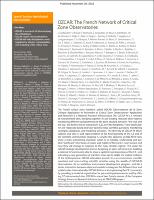Mostrar el registro sencillo del ítem
OZCAR: The French network of critical zone observatories
| dc.contributor.author | Gaillardet, J. | |
| dc.contributor.author | Braud, I. | |
| dc.contributor.author | Hankard, F. | |
| dc.contributor.author | Anquetin, S. | |
| dc.contributor.author | Bour, O. | |
| dc.contributor.author | Dorfliger, N. | |
| dc.contributor.author | de Dreuzy, J.R. | |
| dc.contributor.author | Galle, S. | |
| dc.contributor.author | Galy, C. | |
| dc.contributor.author | Gogo, S. | |
| dc.contributor.author | Gourcy, L. | |
| dc.contributor.author | Habets, F. | |
| dc.contributor.author | Laggoun, F. | |
| dc.date.accessioned | 2019-07-07T19:11:11Z | |
| dc.date.available | 2019-07-07T19:11:11Z | |
| dc.date.issued | 2018-11 | |
| dc.identifier.uri | http://repositorio.senamhi.gob.pe/handle/20.500.12542/42 | |
| dc.description.abstract | The French critical zone initiative, called OZCAR (Observatoires de la Zone Critique–Application et Recherche or Critical Zone Observatories–Application and Research) is a National Research Infrastructure (RI). OZCAR-RI is a network of instrumented sites, bringing together 21 pre-existing research observatories monitoring different compartments of the zone situated between “the rock and the sky,” the Earth’s skin or critical zone (CZ), over the long term. These observatories are regionally based and have specific initial scientific questions, monitoring strategies, databases, and modeling activities. The diversity of OZCAR-RI observatories and sites is well representative of the heterogeneity of the CZ and of the scientific communities studying it. Despite this diversity, all OZCAR-RI sites share a main overarching mandate, which is to monitor, understand, and predict (“earthcast”) the fluxes of water and matter of the Earth’s near surface and how they will change in response to the “new climatic regime.” The vision for OZCAR strategic development aims at designing an open infrastructure, building a national CZ community able to share a systemic representation of the CZ, and educating a new generation of scientists more apt to tackle the wicked problem of the Anthropocene. OZCAR articulates around: (i) a set of common scientific questions and cross-cutting scientific activities using the wealth of OZCAR-RI observatories, (ii) an ambitious instrumental development program, and (iii) a better interaction between data and models to integrate the different time and spatial scales. Internationally, OZCAR-RI aims at strengthening the CZ community by providing a model of organization for pre-existing observatories and by offering CZ instrumented sites. OZCAR is one of two French mirrors of the European Strategy Forum on Research Infrastructure (eLTER-ESFRI) project. | en_US |
| dc.description.sponsorship | OZCAR-RI is supported by the French Ministry of Education and Research, through the Allenvi Alliance. OZCAR observatories have benefited from numerous sources of funding coming from the different research institutions supporting the infrastructure (ANDRA, BRGM, CEA, CNES, CNRS, Ifsttar, INRA, IPEV, IPGP, IRD, IRSN, Irstea, Météo-France, LNE), universities (Avignon Pays de Vaucluse, Bourgogne Franche-Comté, Bretagne Occidentale, Grenoble-Alpes, La Réunion, Lyon, Montpellier, Orléans, Paris Diderot, Pierre et Marie Curie, Rennes, Rouen-Normandie, Savoie-Mont Blanc, Strasbourg, Toulouse, Clermont-Auvergne), and institutes (INP-Toulouse, Mines Telecom, VetAgroSup, IPGP). In the southern countries, the following universities—UCAM, TREMA International Joint Laboratory, Morocco; lNRGREF, INAT, Tunisia; Univ. Abdou Moumouni, Niger; Univ. Abomey-Calavi, Bénin; Univ. des Sciences des Techniques et des Technologies de Bamako, Mali; UFAM in Manaus, Brazil; UFF in Rio de Ja-neiro, Brazil; UNALM in Lima, Peru; UMSA in La Paz, Bolivia; UCV in Caracas, Venezuela; UMNG in Brazaville, Republic of the Congo—as well as the following national hydrological services—ANA, CPRM in Brazil, SENAMHI in Peru and Bolivia, INAMHI in Ecuador, and DREAL in France—are thanked for making international collaboration possible. The French Ministry of Ecological and Inclusive Transition (AFB/ONEMA) is supporting the piezometer network (ROSES). A number of sites were supported by the ANR and PIA (Programme Investisse-ment d’Avenir): Equipex CRITEX (ANR-11-EQPX-0011), LabexOSUG@2020, Labex DRIIHM–OHM du Haut Vicdessos. We also thank the administrative and scientific staff of all institutions contributing to the collection, analysis, and diffusion of the data collected within OZCAR. Tim White and two anonymous reviewers are thanked for their suggestions that improved the manuscript. Lin Ma and Nicole Fernadez are thanked in particular for their careful proofreadings. | en_US |
| dc.format | application/pdf | |
| dc.language.iso | eng | en_US |
| dc.publisher | Soil Science Society of America | en_US |
| dc.relation.ispartof | urn:issn:1539-1663 | |
| dc.rights | info:eu-repo/semantics/openAccess | es_PE |
| dc.rights | Attribution-NonCommercial-ShareAlike 3.0 United States | * |
| dc.rights.uri | http://creativecommons.org/licenses/by-nc-sa/3.0/us/ | * |
| dc.source | Servicio Nacional de Meteorología e Hidrología del Perú | es_PE |
| dc.source | Repositorio Institucional - SENAMHI | es_PE |
| dc.subject | Hidrología | en_US |
| dc.subject | Climatic regimes | en_US |
| dc.subject | Development programs | en_US |
| dc.subject | Monitoring strategy | en_US |
| dc.subject | Research infrastructure | en_US |
| dc.subject | Scientific activity | en_US |
| dc.subject | Scientific community | en_US |
| dc.subject | Strategic development | en_US |
| dc.subject | Wicked problems | en_US |
| dc.title | OZCAR: The French network of critical zone observatories | en_US |
| dc.type | info:eu-repo/semantics/article | es_PE |
| dc.identifier.isni | 0000 0001 0746 0446 | |
| dc.description.peerreview | Por pares | |
| dc.identifier.doi | https://doi.org/10.2136/vzj2018.04.0067. | |
| dc.source.volume | 17 | es_PE |
| dc.source.issue | 1 | es_PE |
| dc.source.initialpage | 1 | es_PE |
| dc.source.endpage | 24 | es_PE |
| dc.source.journal | Vadose Zone Journal | es_PE |
| dc.subject.ocde | https://purl.org/pe-repo/ocde/ford#1.05.11 |
Ficheros en el ítem
Este ítem aparece en la(s) siguiente(s) colección(es)
-
Artículo científico [166]









